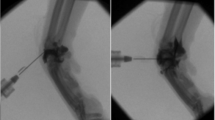Abstract
Purpose
Carpal ligaments can be classified as intrinsic and extrinsic. Extrinsic ligaments are often involved in carpal instability. The purpose of this article is to describe the sonographic appearance of extrinsic carpal ligaments on high-resolution ultrasound (HRUS) using magnetic resonance arthrography (MR arthrography) as a reference standard.
Materials and methods
We studied both wrists in 18 healthy volunteers (ten men, eight women, age range 18–58 years, mean age 34 years) with a Philips iU22 US scanner equipped with a high-resolution linear-array broadband transducer (5–17 MHz). The scans were performed along the long axis of the extrinsic dorsal and ventral ligaments to assess their course, thickness and structure. Ten subjects were also studied with MR arthrography of the wrist.
Results
In all patients, the ligament components could be appreciated as thin fibrillar hyperechoic structures. The course of seven extrinsic carpal ligaments and their relationships with surrounding articular structures could be studied. The radioscapholunate and the ulnar collateral ligaments were not visible on US. MR arthrography depicted all ligaments except for the ulnar collateral, which was never visualised.
Conclusions
The results obtained are consistent with those reported in the literature. HRUS provides good anatomical detail of the extrinsic carpal ligaments, but the role of US in planning the treatment of carpal instability disorders is yet to be demonstrated.
Riassunto
Obiettivo
I legamenti del carpo sono suddivisi in intrinseci ed estrinseci. Questi ultimi sono spesso coinvolti nella patogenesi dell’instabilità carpale. L’obiettivo di questo studio è descrivere l’aspetto ecografico dei legamenti estrinseci del carpo mediante ecografia ad alta risoluzione, utilizzando l’artrografia a risonanza magnetica (artro-RM) come metodica di riferimento.
Materiali e metodi
Abbiamo studiato entrambi i polsi di 18 soggetti volontari sani (10 maschi, 8 femmine, range 18–58 anni, età media 34 anni) mediante un apparecchio Philips iU22 con trasduttore lineare ad alta risoluzione (5–17 MHz). Sono state effettuate scansioni lungo l’asse lungo dei legamenti estrinseci dorsali e ventrali per poterne valutare il decorso, lo spessore e l’ecostruttura. In 10 casi è stato inoltre eseguito un esame artro-RM di polso.
Risultati
In tutti i soggetti è stato possibile riconoscere le componenti legamentose come sottili strutture fibrillari iperecogene. È stato possibile individuare il decorso di sette legamenti estrinseci del carpo ed i rapporti con le strutture articolari circostanti. I legamenti radioscafolunato e collaterale ulnare non sono risultati visibili ecograficamente. Le immagini artro-RM hanno dimostrato tutti i legamenti estrinseci ad eccezione del legamento collaterale ulnare, mai visualizzato.
Conclusioni
I dati ottenuti concordano con quelli presenti in letteratura. L’ecografia ad alta risoluzione ci permette di studiare i legamenti estrinseci del carpo con un buon dettaglio anatomico ma il ruolo dell’ecografia nell’iter terapeutico delle patologie da instabilità del carpo rimane da dimostrare.
Similar content being viewed by others
References/Bibliografia
Ozcelik A, Gunal I, Kose N et al (2005) Wrist ligaments: their significance in carpal instability. Ulus Travma Acil Cerrahi Derg 11:115–120
Schmitt R, Frochner S, Coblenz G et al (2006) Carpal instability. Eur Radiol 16:2161–2178
Linn MR, Mann FA, Gilula LA (1990) Imaging of the symptomatic wrist. Orthop Clin North Am 21:512–543
Mayfield JK (1992) Wrist ligament anatomy and biomechanics. In: Gilula LA (ed) The traumatized hand and wrist: radiographic and anatomic correlation. Saunders, Philadelphia, pp 241–248
Taleinsnik J (1976) The ligaments of the wrist. J Hand Surg 1A:110–118
Van Holsbeeck MT, Introcaso JH (2001) Musculoskeletal ultrasound, 2nd edition. Mosby, St Louis
Martino F, Silvestri E, Grassi W et al (2006) Musculoskeletal ultrasound of joint disorders. Springer, Milano
Lin EC, Middleton WD, Teefey SA (1999) Extended field of view sonography in musculoskeletal imaging. J ultrasound Med 18:147–152
Landis JR, Kock GG (1977) The measurement of observer agreement for categorical data. Biometrics 33:159–174
Linscheid RL, Dobyns JH, Beabout JW et al (1972) Traumatic instability of the wrist: diagnosis, classification and pathomechanics. J Bone Surg 54A:1612–1632
Viegas SF, Patterson RM, Ward K (1995) Extrinsic wrist ligaments in the pathomechanics of ulnar translation instability. J Hand Surg 20A:312–318
Wright TW, Dobyns JH, Linscheid RL et al (1994) Carpal instability non-dissociative. J Hand Surg [Br] 19:763–773
Theumann NH, Pfirrmann CW, Antonio GE et al (2003) Extrinsic carpal ligaments: normal MR arthrographic appearance in cadavers. Radiology 226:171–179
Brown RR, Fliszar E, Cotten A et al (1998) Extrinsic and intrinsic ligaments of the wrist: normal and pathological anatomy at MR arthrography with three-compartment enhncement. Radiographics 18:667–674
Jacobson GA, Oh E, Propeck T et al (2002) Sonography of the scapholunate ligament in four cadaveric wrist: correlation with MR arthrography and anatomy. AJR Am J Roentgenol 179:523–527
Adler BD, Logan PM, Janzen DL (1996) Extrinsic radiocarpal ligaments: magnetic resonance imaging of normal wrists and scapholunate dissociation. Can Assoc Radiol J 47:417–422
Metz VM, Mann FA, Gilula LA (1993) Three-compartment wrist arthrography: correlation of pain site with location of uni-and bidirectional communications. AJR Am J Roentgenol 160:819–822
Schmitt R, Christopoulous G, Meier R et al (2003) Direct MR arthrography of the wrist in comparison with arthroscopy: a prospective study on 125 patients. Fortschr Rontgenstr 175:911–919
Freeland AE, Ferguson CA, McCraney WO (2006) Palmar radiocarpal dislocation resulting in ulnar radiocarpal translocation and multidirectional instability. Orthopedics 29:604–608
Boutry N, Lapegue F, Masi L et al (2005) Ultrasonographic evaluation of normal extrinsic and intrinsic carpal ligaments: preliminary experience. Skeletal Radiol 34:513–521
Author information
Authors and Affiliations
Corresponding author
Rights and permissions
About this article
Cite this article
Lacelli, F., Muda, A., Sconfienza, L.M. et al. High-resolution ultrasound anatomy of extrinsic carpal ligaments. radiol med 113, 504–516 (2008). https://doi.org/10.1007/s11547-008-0269-2
Received:
Accepted:
Published:
Issue Date:
DOI: https://doi.org/10.1007/s11547-008-0269-2



